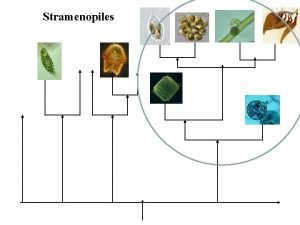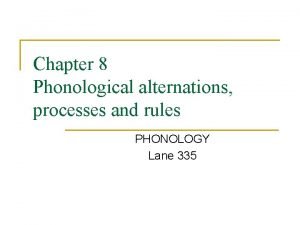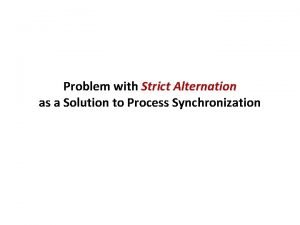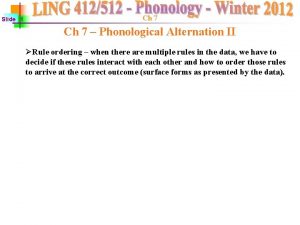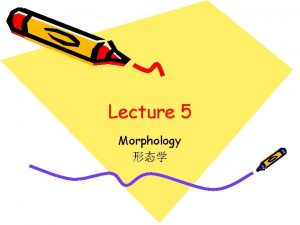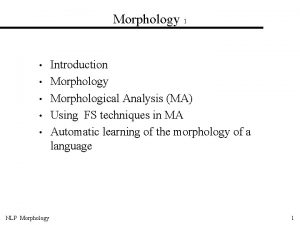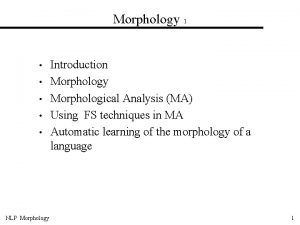Morphology 3 Ling 400 correction singsang alternation iswas






![Turkish data Answers: a. [deniz] ‘ocean’ [de] ‘in’ [im] ‘my’ [ev] ‘house’ [e] ‘to Turkish data Answers: a. [deniz] ‘ocean’ [de] ‘in’ [im] ‘my’ [ev] ‘house’ [e] ‘to](https://slidetodoc.com/presentation_image_h/352e9b9b3292479adfbf38c516a5dd62/image-7.jpg)


![Morphophonemic Rule Plural morpheme in English books [b. Uks], baths [b. QTs], bat [b. Morphophonemic Rule Plural morpheme in English books [b. Uks], baths [b. QTs], bat [b.](https://slidetodoc.com/presentation_image_h/352e9b9b3292479adfbf38c516a5dd62/image-10.jpg)
![Morphophonimic Rule Plural morpheme in English - Generalization [´] after sibilant Otherwise: [s] after Morphophonimic Rule Plural morpheme in English - Generalization [´] after sibilant Otherwise: [s] after](https://slidetodoc.com/presentation_image_h/352e9b9b3292479adfbf38c516a5dd62/image-11.jpg)





- Slides: 16

Morphology 3 Ling 400

correction • sing/sang: alternation • is/was: suppletion

Language Types • Analytic (or Isolating) Languages one word = one morpheme Example: Chinese • Synthetic Languages one word may consist of multiple morphemes

Synthetic Languages (subtypes) Agglutinating Languages Example: Turkish, Japanese John-ga Bill-o mi-ta. John-subj Bill-obj see-PAST Fusional Languages (not easy to identify each morpheme --- bound morphemes are “fused” to the stem) Example: Spanish (see text) Polysynthetic Languages One sentence can consist of “one word” Example: Sora (spoken in India)

Turkish data

Turkish data
![Turkish data Answers a deniz ocean de in im my ev house e to Turkish data Answers: a. [deniz] ‘ocean’ [de] ‘in’ [im] ‘my’ [ev] ‘house’ [e] ‘to](https://slidetodoc.com/presentation_image_h/352e9b9b3292479adfbf38c516a5dd62/image-7.jpg)
Turkish data Answers: a. [deniz] ‘ocean’ [de] ‘in’ [im] ‘my’ [ev] ‘house’ [e] ‘to [in] ‘of’ [el] ‘hand’ [den] ‘from [imiz] ‘our’ [di. S] ‘tooth’ [d. ZIk] ‘little’ [ler] (plural) b. noun + ‘little’ + plural + determiner + preposition (postposition to be exact) c. [eld. ZIklerimizin]

Cebuano

Cebuano • • • Questions: State the rule (in words, precisely) for deriving language names from the names of ethnic group. What type of affixation is this? • • • Answers: Insert [in] before the first vowel Affixation (infixing and prefixing)
![Morphophonemic Rule Plural morpheme in English books b Uks baths b QTs bat b Morphophonemic Rule Plural morpheme in English books [b. Uks], baths [b. QTs], bat [b.](https://slidetodoc.com/presentation_image_h/352e9b9b3292479adfbf38c516a5dd62/image-10.jpg)
Morphophonemic Rule Plural morpheme in English books [b. Uks], baths [b. QTs], bat [b. Qts] lids [l. Idz], pins [p. Inz], days [dez] judges [d. Z√d. Z´z], wishes [w. IS´z], kisses [k. Is´z]
![Morphophonimic Rule Plural morpheme in English Generalization after sibilant Otherwise s after Morphophonimic Rule Plural morpheme in English - Generalization [´] after sibilant Otherwise: [s] after](https://slidetodoc.com/presentation_image_h/352e9b9b3292479adfbf38c516a5dd62/image-11.jpg)
Morphophonimic Rule Plural morpheme in English - Generalization [´] after sibilant Otherwise: [s] after [-voice], [z] after [+voice] Rules: (1) suffix /z/ to any noun for plurality (2) Insert [´] before the /z/ if the noun ends in a sibilant (3) /z/ [-voice] / [-voice] ___

Morphophonemic Rule This is a phonological process but is morphologically conditioned. It is sometimes referred to as a morphophonemic rule/process. Why? The rule applies only when /z/ indicates plurality: peace [pis] vs. peas [piz] race [®e. Is] vs. rays [®e. Iz] rice [®AIs ] vs. ryes [®AIz ]

Analysis of English words How many morphemes? denationalization

Analysis of English words 5 morphemes structure? N de-nation-al-iza-tion whole word: N

N V V Adj pref N suf suf de- nation -al -ize -tion

Analysis of English words Simplification -- How many morphemes? Simpl(e)-fy-cation 3 Similar example: modifi(y) - cation N V N simpli suf -fi suf -cation
 200 + 200 = 400
200 + 200 = 400 Derivational morphology and inflectional morphology
Derivational morphology and inflectional morphology Faktor faktor yang mempengaruhi perubahan
Faktor faktor yang mempengaruhi perubahan Ferns alternation of generations
Ferns alternation of generations Alternation theorem in dsp
Alternation theorem in dsp What is isomorphic alternation of generation
What is isomorphic alternation of generation Alternation of generation fern
Alternation of generation fern Phonological alternation examples
Phonological alternation examples Alternation of generations
Alternation of generations Strict alternation
Strict alternation Single character alternation in regexp
Single character alternation in regexp Plant life cycles and alternation of generations
Plant life cycles and alternation of generations Ganetophyte
Ganetophyte Alternation of generations
Alternation of generations Busy waiting in os
Busy waiting in os Alternation in phonology
Alternation in phonology Wai ling lam
Wai ling lam





